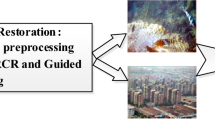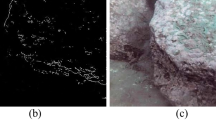Abstract
Because underwater and low-light images have different characteristics, there are few methods to jointly improve the visibility of these images. This paper proposes a de-hazing and enhancement method for underwater and low-light images to describe the two types of images uniformly. Multi-scale retinex color recovery (MSRCR) and guided filtering methods are used for de-hazing; the proposed method of white balance fusion global guided image filtering (G-GIF), effectively solve the problems of dim light, color distortion, and loss of edge details. Experiments show that compared with other methods, this method can effectively solve the image exposure, and at the same time, it can better protect and enhance the image’s color saturation and edge texture details, thus achieving a very good visual effect.







Similar content being viewed by others
References
Berman D, Treibitz T, Avidan S (2016) Non-local image de-hazing. In: Proceedings of Proc IEEE Conf Comput Vis Pattern Recognit, pp: 1674–1682
Bertalmío M, Levine S (2013) Variational approach for the fusion of exposure bracketed pairs. IEEE Trans Image Process 22(2):712–723
Chiang JY, Chen YC (2012) Underwater image enhancement by wavelength compensation and dehazing. IEEE Trans Image Process 21(4):1756–1769
Dai CG, Lin MX, Wang JK, Hu X (2019) Dual-purpose method for underwater and low-light image enhancement via image layer separation. IEEE Access 7:178685–17869806
Ding X, Wang Y, Zhang J, Fu X (2017) Underwater image dehaze using scene depth estimation with adaptive color correction. In: Proceedings of Proc IEEE OCEANS Aberdeen, pp: 1–5
Drews-Jr P, Nascimento ER, Botelho SSC, Campos MFM (2016) Underwater depth estimation and image restoration based on single images. IEEE Comput Graph Appl 36(2):24–35
Galdran A, Pardo D, Picon A, Alvarez-Gila A (2015) Automatic red-channel underwater image restoration. J Vis Commun Image Represent 26(2):132–145
Ghani ASA (2018) Image contrast enhancement using an integration of recursive-overlapped contrast limited adaptive histogram specification and dual-image wavelet fusion for the high visibility of deep underwater image. Ocean Eng 162:224–238
Ghani ASA, Isa NAM (2015) Underwater image quality enhancement through integrated color model with rayleigh distribution. Appl Soft Comput 27(3):219–230
Hao S, Han X, Guo Y, Xu X, Wang M (2020) Low-light image enhancement with semi-decoupled decomposition. IEEE Trans Multimedia 22(12):3025–3038
He K, Sun J, Tang X (2011) Single image haze removal using dark channel prior. IEEE Trans Pattern Anal Mach Intell 33(12):2341–2353
Hou GJ, Li JM, Wang GD, Pan ZK, Zhao X (2020) Underwater image dehazing and denoising via curvature variation regularization. Multimed Tools Appl 79(27):20199–20219
Jing H, Liu YY (2018) Urban Night Image Restoration Algorithm Based on Space Model. In: Proceedings of IEEE 3rd International Conference on Image, Vision and Computing (ICIVC), pp: 27–29
Kumar M, Bhandari AK (2020) Contrast enhancement using novel white balancing parameter optimization for perceptually invisible images. IEEE Trans Image Process 9:525–7536
Lee S, An GH, Kang SJ (2018) Deep chain HDRI: reconstructing a high dynamic range image from a single low dynamic range image. IEEE Access 6:49913–49924
Li C, Guo J (2015) Underwater image enhancement by de-hazing and color correction. J Electron Imag 24:033023–033023
Li Z, Zheng J (2018) Single image De-hazing using globally guided image filtering. IEEE Trans Image Process 27(1):442–450
Li CY, Guo JC, Pang YW, Chen SJ, Wang J (2016) SINGLE UNDERWATER IMAGE RESTORATION BY BLUE-GREEN CHANNELS DEHAZING AND RED CHANNEL CORRECTION. In: Proceedings of Proc IEEE International Conference on Acoustics, Speech and Signal Processing (ICASSP), pp: 20–25
Li CY, Guo JC, Cong RM, Pang YW, Wang B (2016) Underwater image enhancement by dehazing with minimum information loss and histogram distribution prior. IEEE Trans Image Process 25(12):5664–5677
Li YJ, Ma CY, ZHANG TT, Li JR, Ge ZY, Li Y, Wa S (2019) Underwater image high definition display using the multilayer perceptron and color feature-based SRCNN. IEEE Access Environ 7:83721–83728
Liu YH, Yan HM, Gao SB, Yang KF (2018) Criteria to evaluate the fidelity of image enhancement by MSRCR. IET Image Process 12(6):880–887
Min D, Choi S, Lu J, Ham B, Sohn K, Do M (2014) Fast global image smoothing based on weighted least squares. IEEE Trans Image Process 23(12):5638–5653
Panetta K, Gao C, Agaian S (2015) Human-visual-system-inspired underwater image quality measures. IEEE J Ocean Eng 41(3):1–11
Peng YT, Cosman PC (2017) Underwater image restoration based on image blurriness and light absorption. IEEE Trans Image Process 26(4):1579–1594
Peng YT, Cao K, Cosman PC (2018) Generalization of the dark channel prior for single image restoration. IEEE Trans Image Process 27(6):2856–2868
Steffens C, Drews PLJ, Botelho SS (2018) Deep Learning Based Exposure Correction for Image Exposure Correction with Application in Computer Vision for Robotics. In: proceedings of 2018 Latin American Robotic Symposium, 2018 Brazilian Symposium on Robotics (SBR) and 2018 Workshop on Robotics in Education (WRE), pp: 6–10
Vasu S, Shenoi A, RajagopaZan AN (2018) Joint HDR and Super-Resolution Imaging in Motion Blur. In: proceedings of 25th IEEE International Conference on Image Processing (ICIP), pp: 7–10
Wang Z, Bovik AC, Sheikh HR, Simoncelli EP (2004) Image quality assessment: from error visibility to structural similarity. IEEE Trans Image Process 13(4):600–612
Wang YF, Huang Q, Hu J (2017) Image enhancement based on adaptive demarcation between low-light and overexposure. In: Proceedings of 2017 International Conference on Progress in Informatics and Computing (PIC), pp: 15–17
Xiao L, Fang CY, Zhu LX, Wang YR, Yu TT, Zhao YX, Zhu D, Fei P (2020) Deep learning-enabled efficient image restoration for 3D microscopy of turbid biological specimens. Opt Express 28(20):30234–30247
Yu HF, Li XB, Lou Q, Lei CB, Liu ZX (2020) Underwater image enhancement based on DCP and depth transmission map. Multimed Tools Appl 79(27–28):20373–20390
Acknowledgments
Thanks to my teachers and classmates for their help in the paper writing; it was with their encouragement and guidance that I finally finished this paper. All the authors who participated in the writing of the manuscript and the review committee of our institution (Shandong University of Science and Technology) expressed their oral consent to the submission of the manuscript.
Funding
The authors acknowledge this paper was supported by the National Key Research and Development Program of China under Grant 2017YFC0804406.
Author information
Authors and Affiliations
Corresponding author
Ethics declarations
Competing interests
The authors declare that there are no conflicts of interest related to this article.
Additional information
Publisher’s note
Springer Nature remains neutral with regard to jurisdictional claims in published maps and institutional affiliations.
Rights and permissions
About this article
Cite this article
Liu, K., Li, X. De-hazing and enhancement method for underwater and low-light images. Multimed Tools Appl 80, 19421–19439 (2021). https://doi.org/10.1007/s11042-021-10740-3
Received:
Revised:
Accepted:
Published:
Issue Date:
DOI: https://doi.org/10.1007/s11042-021-10740-3




